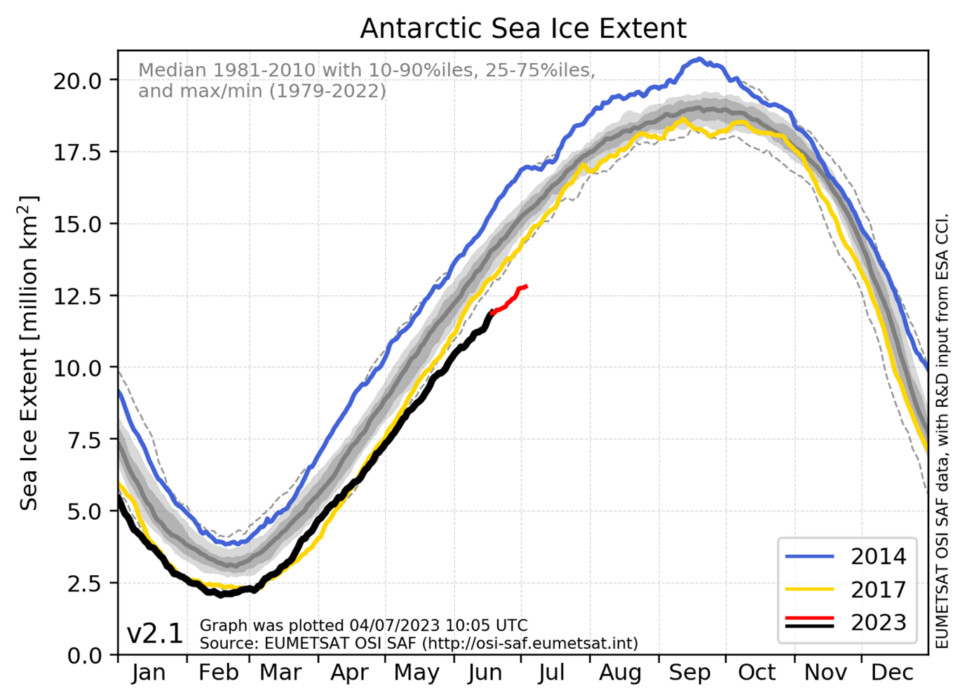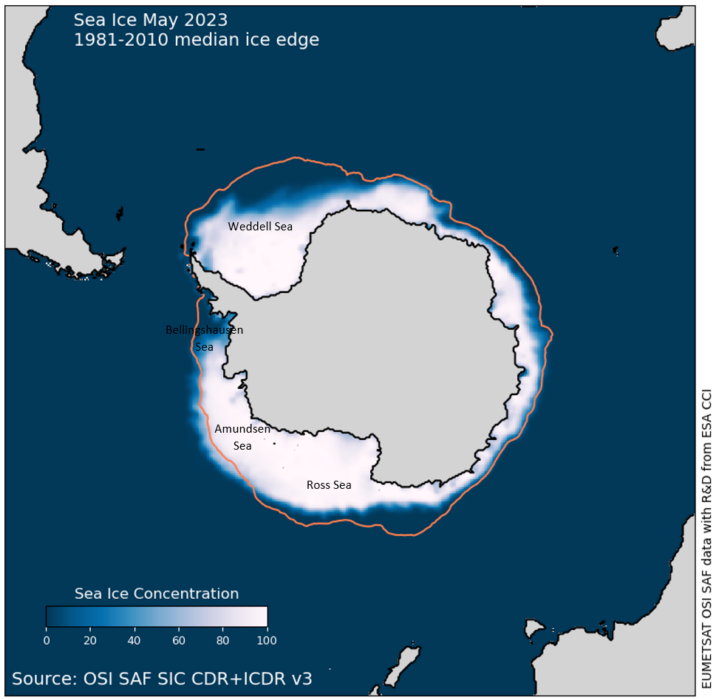The Antarctic sea ice extent for May and June have reached record lows, by a significant margin, since the beginning of satellite records. The large deficits of sea ice in the Weddell Sea, Bellingshausen Sea, and the western part of the Ross Sea (see figure 6) have raised concerns among scientists and researchers.
Generally, the Antarctic freezing season starts in March with sea ice extent increasing steadily until September. The January, February and May Antarctic Sea ice extent was already at a record low this year, and the month of June shows the lowest levels of sea ice extent for this period since the beginning of the satellite record (figure 5).

- Antarctic sea ice extent is at a record low for May and June 2023, the lowest on satellite record for this period by a significant margin (figure 5, shows the June record low, that is well below years past).
- There is a loss of nearly 2.20 million km2 of Antarctic sea ice in June compared to the long-term average for June (1981 to 2010 climatology),[1] an equivalent to a loss of nearly the size of the Kingdom of Denmark in sea ice.
- June 2023 is almost a month behind normal sea ice conditions compared to the long-term average (1981-2010) for the ice expansion season.
- This occurrence comes after 2 years of consecutive record-setting lows for sea ice extent in February, the period when sea ice reaches its minimum during the year.

- There is a large deficit of sea ice in Weddell Sea, Bellingshausen Sea and the western part of Ross Sea (figure 6, the orange line represents the long-term average of sea ice concentration, and in comparison, the white zone represents sea ice concentration for May that has receded significantly).
For the last two years there have been record-setting lows for Antarctic sea ice extent in February[2], the austral summer, a period when sea ice reaches its minimum during the year. The sea ice coverage averaged for February 2023 (the lowest ever observed for this period) represents a 13% loss in sea ice when compared to the 2022 record. And the February 2023 low represented 38% loss in sea ice when compared to the long-term average (1979 – 2022 climatology), according to figures from the EUMETSAT Ocean and Sea Ice Satellite Application Facility (OSI SAF) products.
These figures underscore the urgent need for a deeper understanding of the causes and consequences of this exceptional first half-year. The Antarctic constitutes a significant element of the Earth’s global climate system and is the motor of global ocean circulation patterns, sometimes referred to as the « ocean’s conveyor belt, » which transports vast amounts of heat, nutrients and oxygen across the planet. This delay in sea ice formation leaves the ocean in contact with the atmosphere for a longer period of the year and this has never been observed before; this can have a significant impact on the upper layers of the Southern Ocean. Combined with the freshening of waters surrounding the melting Antarctic continent, this can disrupt the oceanic circulation and potentially alter regional and global climate patterns, with far-reaching repercussions for ecosystems and humanity.
Important links
- Copernicus Marine Service, February 2023: Antarctic summer sea ice minimum, the lowest ever observed
- Met Office, June 2023, Briefing on Arctic and Antarctic sea ice – June 2023
- EUMETSAT OSI SAF HL Processing Centre, Sea Ice Index
[1] https://osisaf-hl.met.no/v2p1-sea-ice-index
[2] https://marine.copernicus.eu/news/antarctic-summer-sea-ice-minimum-lowest-ever-observed
